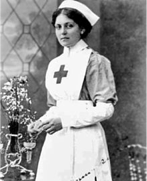“Abandon Ship!” – the fearful cry that Violet Jessop must have heard several times during her working life.

She was an ocean liner stewardess and nurse who survived the disastrous sinkings of both the RMS Titanic in 1912, her sister ship, the HMHS Britannia in 1916, and she had also been on board the RMS Olympic , the eldest of the three sister ships, owned by the White Star Line, when it collided with a British warship in 1911.
She was born in Argentina, the eldest daughter of Irish immigrants, William and Katherine Jessop. She was the first of nine children, six of whom survived. Her father died and the family moved to England, where she attended a convent school and cared for her youngest sister while her mother was away at sea working as a stewardess.
When her mother became ill, she left school, and to provide for her siblings, she followed in her mother’s footsteps, and applied to be a stewardess.
Olympic
In 1910, Jessop started working as a stewardess on the White Star vessel, RMS Olympic. She was on board on 20 September 1911, when the Olympic left Southampton and collided with the British warship, HMS Hawke. There were no fatalities and despite considerable damage, the ship was able to make it back to port without sinking.
Titanic
She boarded the RMS Titanic as a stewardess on 10 April 1912. Four days later, the ship struck an iceberg in the North Atlantic Ocean and sank. She described in her memoirs how she was ordered up on deck to help any non-English speakers who could not follow the instructions given to them.
“I was ordered up on deck. Calmly, passengers strolled about. I stood at the bulkhead with the other stewardesses, watching the women cling to their husbands before being put into the boats with their children. Sometime after, a ship’s officer ordered us into the boat first to show some women it was safe.”
She was ordered into lifeboat 16, and, as the boat was being lowered, one of the Titanic’s officers gave her a baby to look after. The next morning, Jessop, the baby, and the rest of the survivors were rescued by the RMS Carpathia .
Britannic
During WWI, Jessop served as a member of the Red Cross. On the morning of 21 November 1916, she was working on board the HMHS Brittanic, a White Star liner that had been converted into a hospital ship, when it sank in the Aegean Sea.
The Britannic sank within 57 minutes, 30 people were lost. As the ship sank, Jessop and other passengers were nearly killed by the boat’s propellers that sucked lifeboats under the stern. In her memoirs, she described the scene she witnessed as the Britannic went under:
“The white pride of the ocean’s medical world … dipped her head a little, then a little lower and still lower. All the deck machinery fell into the sea like a child’s toys. Then she took a fearful plunge, her stern rearing hundreds of feet into the air until with a final roar, she disappeared into the depths.”
She had to jump out of her lifeboat and received a traumatic head wound, but survived despite her injuries.
“I leapt into the water but was sucked under the ship’s keel which struck my head. I escaped, but years later when I went to my doctor because of a lot of headaches, he discovered I had once sustained a fracture of the skull!”

After the war, Jessop continued to work for the White Star Line, before joining the Red Star Line and then the Royal Mail Line again. During her tenure with Red Star, Jessop went on two around the world cruises on the company’s largest ship, the Belgenland .
Luckily for Violet, and other seamen and passengers, no other vessel she boarded sustained significant damage again.
She was obviously a great survivor and she earned the nickname “Miss Unsinkable”.